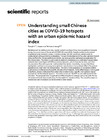Understanding small Chinese cities as COVID-19 hotspots with an urban epidemic hazard index
dc.contributor.author
Li, Tianyi
dc.contributor.author
Luo, Jiawen
dc.contributor.author
Huang, Cunrui
dc.date.accessioned
2021-08-06T12:11:17Z
dc.date.available
2021-07-31T02:40:55Z
dc.date.available
2021-08-06T12:11:17Z
dc.date.issued
2021-07-11
dc.identifier.issn
2045-2322
dc.identifier.other
10.1038/s41598-021-94144-1
en_US
dc.identifier.uri
http://hdl.handle.net/20.500.11850/498806
dc.identifier.doi
10.3929/ethz-b-000498806
dc.description.abstract
Multiple small- to middle-scale cities, mostly located in northern China, became epidemic hotspots during the second wave of the spread of COVID-19 in early 2021. Despite qualitative discussions of potential social-economic causes, it remains unclear how this unordinary pattern could be substantiated with quantitative explanations. Through the development of an urban epidemic hazard index (EpiRank) for Chinese prefectural districts, we came up with a mathematical explanation for this phenomenon. The index is constructed via epidemic simulations on a multi-layer transportation network interconnecting local SEIR transmission dynamics, which characterizes intra- and inter-city population flow with a granular mathematical description. Essentially, we argue that these highlighted small towns possess greater epidemic hazards due to the combined effect of large local population and small inter-city transportation. The ratio of total population to population outflow could serve as an alternative city-specific indicator of such hazards, but its effectiveness is not as good as EpiRank, where contributions from other cities in determining a specific city’s epidemic hazard are captured via the network approach. Population alone and city GDP are not valid signals for this indication. The proposed index is applicable to different epidemic settings and can be useful for the risk assessment and response planning of urban epidemic hazards in China. The model framework is modularized and the analysis can be extended to other nations.
en_US
dc.format
application/pdf
en_US
dc.language.iso
en
en_US
dc.publisher
Macmillan Publishers
en_US
dc.rights.uri
http://creativecommons.org/licenses/by/4.0/
dc.title
Understanding small Chinese cities as COVID-19 hotspots with an urban epidemic hazard index
en_US
dc.type
Journal Article
dc.rights.license
Creative Commons Attribution 4.0 International
ethz.journal.title
Scientific Reports
ethz.journal.volume
11
en_US
ethz.journal.abbreviated
Sci Rep
ethz.pages.start
14663
en_US
ethz.size
10 p.
en_US
ethz.version.deposit
publishedVersion
en_US
ethz.identifier.wos
ethz.identifier.scopus
ethz.publication.place
London
en_US
ethz.publication.status
published
en_US
ethz.date.deposited
2021-07-31T02:41:00Z
ethz.source
SCOPUS
ethz.eth
yes
en_US
ethz.availability
Open access
en_US
ethz.rosetta.installDate
2021-08-06T12:11:23Z
ethz.rosetta.lastUpdated
2022-03-29T10:58:34Z
ethz.rosetta.versionExported
true
ethz.COinS
ctx_ver=Z39.88-2004&rft_val_fmt=info:ofi/fmt:kev:mtx:journal&rft.atitle=Understanding%20small%20Chinese%20cities%20as%20COVID-19%20hotspots%20with%20an%20urban%20epidemic%20hazard%20index&rft.jtitle=Scientific%20Reports&rft.date=2021-07-11&rft.volume=11&rft.spage=14663&rft.issn=2045-2322&rft.au=Li,%20Tianyi&Luo,%20Jiawen&Huang,%20Cunrui&rft.genre=article&rft_id=info:doi/10.1038/s41598-021-94144-1&
Files in this item
Publication type
-
Journal Article [128832]

